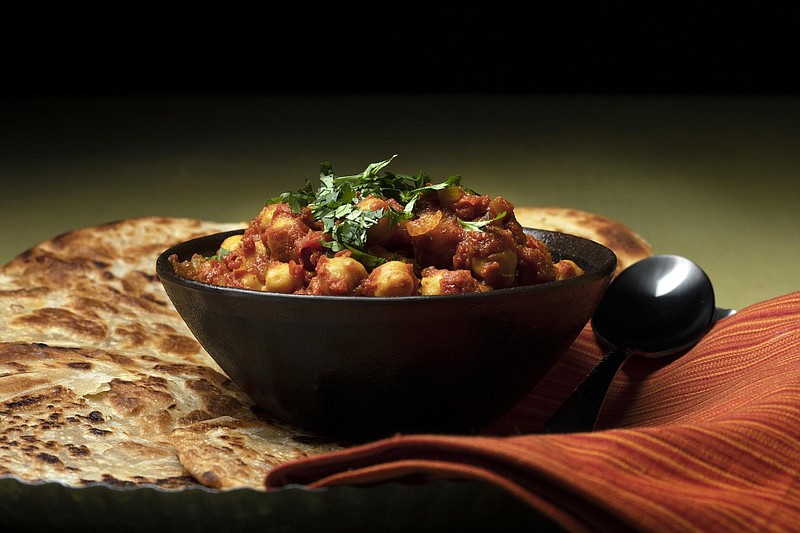So, Madge and I got totally into it the other day over my chimpanzee butler. Something about the way he dresses, Madge found it, I don't know - "unseemly."
"What, the bowtie?" I asked. "Too much?"
"Not just the bowtie," she said, shaking her head. "It's the whole 'chimps as butlers' thing."
"What are you talking about? Mandrake likes being my butler, don't you, Mandrake," I said, with an appreciative nod in the direction of the smartly attired primate.
"Oh, for the love of " said Madge, "What do chimps even know about buttling?" Madge turned to face me directly: "It's like an Irish American rube like yourself writing about something like like "
"Chana masala?" said I.
"Chana masala," said she.
Et, voil.
Why you need to learn this
There are more than 1.7 billion with a "b" people on the Indian subcontinent, all of whom eat food. Chana masala is a relatively simple dish that can crack the door to the cuisines of that region. Be nice to your tongue and give it a try.
The steps you take
Before we begin, Chumley, let's get something straight: We're not going into this thinking we can cook something here in the U.S. that tastes exactly like what we'd get in Mumbai or Sirpur-Kagaznagar. There are simply far too many factors over which we have little to no control.
For example, we think that chickpeas are chickpeas, right? Turns out, the chickpeas known as chana (from which this dish derives its name) are not that common here in the U.S. Chana is smaller and darker than the beige and chubby chickpeas we're used to, which Indians would call "chole" (CHO-lay).
Fear not, though, because what we can do is reproduce some of the flavor profiles of Indian food, and chana masala is a great place to start.
The word "masala" masala refers either to a blend of raw or toasted spices or, perhaps more frequently, a mix of ingredients like tomato, onion, garlic and ginger that are sauteed together along with various spices. It's to this mixture, then, that the main ingredient (in today's iteration, chickpeas) is added to simmer until it's done.
Now, because items like tomato, onion and garlic are as common in contemporary global cuisine as pigs were in the streets of 1830 Cincinnati, those three items alone will not give you an "Indian-tasting" masala. The ginger will certainly help; fresh ginger is a staple in the cuisines of South Asia. What really makes your masala Indian, though, are those spices. Let's talk about that.
First of all, we should address the elephant in the room: curry powder. Most of us have a small container of curry powder in our spice cabinet. When I was younger and even dumber than I am now, I made "Indian food" by stir-frying veggies with curry powder. What I didn't realize was that curry powder is not really from the Indian subcontinent. Sure, it contains spices common in Indian and Pakistani cuisine, but, it's from England. Like fish and chips, Eton mess and Julie Andrews.
The British latched onto curry powder owing to (at least) two factors: First, the centuries-long British occupation of India that didn't end until 1947, and, second, the fact that the British, inhabiting a cold climate, had no built-in experience with the myriad spices native to the warmer corners of the planet. The Brits liked Indian food, but all those spices were far too complicated to master. Hence, curry powder became the shortcut, just like jarred red sauce for your pasta is a shortcut. And, like jarred red sauce, curry powder tastes fine - but, it's just not quite right. Dig?
Now, far be it for me to tell you not to use curry powder.
Still, if you want to start understanding the cuisines of the Indian subcontinent, I'd suggest peaking behind that curry powder curtain to behold those individual spices.
Admittedly, that task and those cuisines can be daunting - so many ingredients, so many unfamiliar flavors - which is why I suggest approaching the topic from a familiar standpoint. Thus:
1. Start your chana masala as you would your favorite red pasta sauce: Saute your aromatics. In Indian cuisine, this would generally be an onion or two - either diced or whirled to a paste in a food processor - along with a small but tasty amount of garlic and ginger. The garlic and ginger can be minced, crushed or, again, whirled to a paste. You can even find jarred garlic-ginger paste in some supermarkets and, trust me, it'll work just fine.
2. Stir into this mixture the main body of your spices. These would commonly include ground coriander, cumin, cayenne and turmeric, but could also include paprika, cinnamon (ground or sticks), cardamom, dried chiles, fenugreek, fennel - the list goes on. If you don't have an Indian grandmother, consult a trusted recipe source for exact amounts.
3. Stir in your tomatoes and saute until most of the liquid evaporates. This is your masala.
4. Add canned chickpeas and, if it's too dry, a little water. Bring it all to a boil, then reduce the heat and let it simmer for 15 to 20 minutes or so to meld all those flavors. Add more water if it's looking too dry. You be the judge.
5. Stir in some lemon juice or amchur (dried mango powder) to brighten the flavors a bit, then add some garam masala and, if you really are feeling crazy, a little lime zest. Garnish it with chopped cilantro (fresh coriander) and serve it with rice or flatbread. Yum.
Chana Masala
Prep: 15 minutes / Cook: 20 to 30 minutes / Makes: 8 servings
Though there's a fair bit of prep and measuring, this recipe is pretty easy. It's based on a recipe given to me by my friend Ravi Balasubramanian, originally from Tamil Nadu, India, now of Chapel Hill, North Carolina. Ingredients that add specific qualities, like heat, sweet, sour, etc., may be increased or decreased to suit individual tastes.
3 tablespoons neutral oil, such as expeller-pressed canola oil
1 tablespoon cumin seeds
1 large onion, cut into small dice
2 ounces (about 3 tablespoons) garlic-ginger paste, see note
1 fresh jalapeno or serrano, minced, or more to taste
1 tablespoon ground coriander
1/2 teaspoon ground cayenne
1 teaspoon ground turmeric
1 can (28 ounces) ground or diced tomatoes
1 can (29 ounces) chickpeas, drained, rinsed
1 teaspoon garam masala
1 tablespoon amchur (dried mango powder) or 1 ounce lemon juice
1 tablespoon brown sugar
Salt as needed
Fresh cilantro, chopped
1. Heat oil in a large, heavy bottomed saucepan over medium heat. Add cumin seeds and onion; cook, stirring, until fragrant and onion is translucent, 1 to 2 minutes.
2. Stir in garlic-ginger paste and minced jalapeno along with coriander, cayenne and turmeric.
3. Add tomatoes and chickpeas; increase heat to bring to a boil, then reduce heat and simmer to thicken slightly and combine flavors, 15 to 20 minutes.
4. Add garam masala, amchur or lemon juice, brown sugar and salt to taste (about 1 teaspoon). Simmer to combine flavors, 5 minutes. Remove from heat and serve immediately, garnished with cilantro.
Nutrition information per serving: 237 calories, 8 g fat, 1 g saturated fat, 0 mg cholesterol, 34 g carbohydrates, 10 g sugar, 9 g protein, 443 mg sodium, 8 g fiber
NOTE: Garlic-ginger paste is available at some grocery stores in tubes or jars. To make it at home, simply pulse roughly equal amounts of peeled, minced garlic and peeled, grated ginger in a food processor with a little oil and salt. It will keep for a couple of months or more in the refrigerator. Or buy garlic paste and ginger paste separately, then mix them together. Leftovers freeze well.


